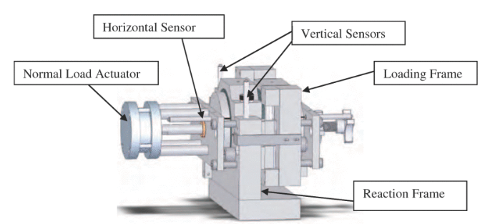- Fall 2022
Pavement Bond Strength
What We Know and Don't Know
There have been several research studies on measuring bond strength between asphalt pavement layers over the past twenty years. And while we’ve learned a great deal from that research, there are still some things we don’t know. So, let’s review what we do know – and what we don’t know – about pavement bond strength.
We know that a good bond between asphalt pavement layers is essential to long-term performance. If pavement layers are not well bonded, stresses induced by traffic loads increase substantially throughout the pavement structure, leading to rapid accumulation of damage and a much shorter pavement life.
Slippage cracking is a common and easily detected bond-related distress. This occurs when the shear stresses at the interface of pavement layers exceed the shear strength of the bond and the pavement begins to slide on top of the underlying surface. Slippage cracks commonly appear at locations where horizontal stresses are the greatest – generally, where heavy vehicles accelerate or decelerate.

Slippage Cracking
We also know that poor interface bonds can create other distresses such as delamination and cracking. Delamination occurs when a portion of the pavement layer is not adequately bonded to an underlying layer. When the pavement deflects vertically under load, the top layer separates further, and in some instances spalls out.

Delamination
Poorly bonded asphalt layers also have a dramatic effect on fatigue cracking and damage to base and subgrade layers. All of the asphalt layers in a pavement structure are designed to act as one single layer. When a pavement is loaded, it bends and deflects, causing a range of complex compressive, tensile, and shear stresses through the pavement structure. In situations where the asphalt layers are not bonded, critical tensile stresses develop above the unbonded interface that can lead to “middle up” cracking. This scenario occurred at the NCAT Test Track in 2003.1

Separated Layers with Surface Cracking

Unbonded Layer at the NCAT Test Track
So, what is necessary to achieve a good bond between asphalt layers? First, the underlying layer should be clean and in fair condition. We know that scabbing, delamination, or severe cracking in the underlying pavement can negatively impact the bond and the performance of the overlay. We also know that the underlying surface needs to be clean. Studies have shown that a small amount of dust or grit on the underlying surface can significantly reduce the bond strength, as the tack material sticks to the dust/grit and not the underlying surface.2, 3
We’ve also learned the importance of a properly applied tack coat. We need to use the correct material, whether it’s an asphalt emulsion or a hot-applied tack, and the correct application rate.3, 4 Application rates from distributors are notoriously incorrect, so a better approach is to measure the application rate directly using ASTM D2995 Standard Practice for Estimating Application Rate and Residual Application Rate of Bituminous Distributors. Another important thing we know about using an emulsion tack coat material is the need for the emulsion to properly break and cure. If the emulsion hasn’t fully broken and cured, it will likely result in tracking by construction equipment and a loss of tack material – primarily in the wheelpaths where it’s most needed. NAPA's Quality Improvement Publication 128 contains helpful information about emulsions, application of tack coats, and methods to prevent tracking.
So now that we’ve reviewed what we know about bonding of asphalt layers, let’s consider some things that we don’t know. There’s an old adage attributed to Lord Kelvin: “If you can not measure it, you can not improve it.” This is appropriate for the bonding of pavement layers and it leads to a few more questions. How should we measure the quality of the bond? What is a suitable criterion, or in other words, how much bond strength is needed?
Let’s start with how bond strengths are measured. In general, there are three basic modes of failure that can occur at the pavement interface: direct shear, torsional shear, and tension.5 There are several different ways they’re measured. NCHRP Project 9-40 identified 20 different in-situ and laboratory bond strength tests in its literature review.3 In 2018, a survey conducted as part of NCHRP Synthesis 516 found that only 12 state DOTs conducted bond strength testing, and the majority used either direct shear or direct tension testing.6 For direct shear, some states use AASHTO TP 114 (developed at the Louisiana Transportation Research Center), which uses a normal force and a shear force applied at 0.1 in./min. Some states use either the ALDOT/NCAT method or similar procedures that don’t use a normal force and load at a faster rate of 2 in./min. Although testing with a normal force is more realistic, an NCAT study in 2005 showed the same ranking of bond strengths with and without normal force, so the recommendation was to use a simpler approach.2 The bottom line is that there is no consensus on the best approach to measure bond strength.

NCAT Bond Strength Test

Louisiana Interface Shear Strength Tester
An important question for any test is variability. In a perfect world, test methods should go through a ruggedness study to determine the impact of permitted variations in testing conditions on the results, such as loading rate, test temperature, core diameter, etc. Once those variables are narrowed down, the variability of the test should be determined through an interlaboratory study. This determines the allowable within- and between-laboratory differences for test results. A 2009 interlaboratory study conducted by a European organization (RILEM) determined that approximately 12% of the within-lab coefficient of variability (COV) for the European Standard direct shear bond strength method (similar to the NCAT method) is attributable to sampling and testing. Recent bond strength testing from seven projects conducted at NCAT found that COVs ranged from approximately 38% to 63%, but this included the materials and construction variability. In other words, the variability of bond strengths from a given project is affected by factors noted above such as surface cleanliness, scabbing, and residual tack coat remaining on the surface. The COVs of the RILEM study and the recent NCAT work suggests that field conditions cause more variability than the test method.
Another question is how much bond strength is required. A follow-up project to NCHRP Project 9-40 recommended a minimum bond strength of 40 psi when using the Louisiana Interlayer Shear Strength Test.7 NCAT recommended a minimum bond strength of 100 psi (based on noted distresses in Alabama) when using the direct shear method developed at NCAT.2, 8 Some states have established their own values based on testing areas with pavement slippage. There is also a wide range of required strengths for direct tension tests.
While it’s important to have good interlayer bond strength, more work is needed to sort out what test should be used, how much variability is in the test, and what the minimum bond strength should be. If those questions can be answered, highway agencies and the asphalt paving industry can work together to eliminate poorly bonded pavements as a cause of failure.
1Willis, J. and D. Timm. Forensic Investigation of a Rich-Bottom Pavement, National Center for Asphalt Technology Report 06-04, Auburn, AL, 2006.
2West, R. C., Zhang, J., and Moore, J. Evaluation of Bond Strength Between Pavement Layers, National Center for Asphalt Technology Report 05-08, Auburn, AL, 2005.
3Mohammad, L. N., Elseifi, M. A., Bae, A., Patel, N., Button, J., and Scherocman, J. A. NCHRP Report 712 Optimization of Tack Coat for HMA Placement. National Cooperative Highway Research Program, Washington, D.C., 2012.
4Decker, Dale S. Best Practices for Emulsion Tack Coats. Quality Improvement Publication 128, National Asphalt Pavement Association, 2013.
5Johnson, D. The Importance of Tack Coats and Interlayer Bond Strengths, Asphalt Magazine, Volume 33, Issue 1, Asphalt Institute, 2018.
6Gierhart, D., & Johnson, D., Tack Coat Specifications, Materials, and Construction Practices. NCJHRP Synthesis 516, The National Academies of Sciences, Engineering, and Medicine 2018.
7Mohammad, L. N., Elseifi, M. A., Das, R., and Cao, W. NCHRP Report 878 Validation of the Louisiana Interlayer Shear Strength Test for Tack Coat National Cooperative Highway Research Program, Washington, D.C., 2018.
8Tran, N.H., R. Willis, and G. Julian, Refinement of the Bond Strength Procedure and Investigation of a Specification, National Center for Asphalt Technology Report 12-04, Auburn, AL, 2012.

For more information about this research, please contact Jim Musselman.